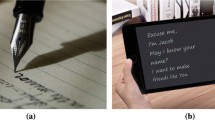Abstract
Now a days, writer identification is at high demand to identify the original writer of the script at high accuracy. The one of the main challenge in writer identification is how to extract the discriminative features of different authors’ scripts to classify precisely. In this paper, the adaptive division method on the offline Latin script has been implemented using several variant window sizes. Fragments of binarized text a set of features are extracted and classified into clusters in the form of groups or classes. Finally, the proposed approach in this paper has been tested on various parameters in terms of text division and window sizes. It is observed that selection of the right window size yields a well positioned window division. The proposed approach is tested on IAM standard dataset (IAM, Institut für Informatik und angewandte Mathematik, University of Bern, Bern, Switzerland) that is a constraint free script database. Finally, achieved results are compared with several techniques reported in the literature.








Similar content being viewed by others
References
Saba, T., & Rehman, A. (2012). Machine learning and script recognition (pp. 35–40). Saarbrücken: Lambert Academic Publisher.
Saba, T., Almazyad, A. S., & Rehman, A. (2015). Online versus offline Arabic script classification. Neural Computing and Applications,. doi:10.1007/s00521-015-2001-1.
Saba, T., Rehman, A., Altameem, A., & Uddin, M. (2014). Annotated comparisons of proposed preprocessing techniques for script recognition. Neural Computing and Applications, 25(6), 1337–1347. doi:10.1007/s00521-014-1618-9.
Rehman, A., & Saba, T. (2014). Neural network for document image preprocessing. Artificial Intelligence Review, 42(2), 253–273. doi:10.1007/s10462-012-9337-z.
Marius, B., & Lambert, S. (2007). Text-independent writer identification and verification using textural and allographic features. IEEE Transactions on Pattern Analysis and Machine Intelligence, 29(4), 701–717.
Neamah, K., Mohamad, D., Saba, T., & Rehman, A. (2014). Discriminative features mining for offline handwritten signature verification. 3D Research,. doi:10.1007/s13319-013-0002-3.
Joudaki, S., Mohamad, D., Saba, T., Rehman, A., Al-Rodhaan, M., & Al-Dhelaan, A. (2014). Vision-based sign language classification: A directional review. IETE Technical Review, 31(5), 383–391. doi:10.1080/02564602.2014.961576.
Saba, T., Rehman, A., & Elarbi-Boudihir, M. (2014). Methods and strategies on off-line cursive touched characters segmentation: A directional review. Artificial Intelligence Review, 42(4), 1047–1066. doi:10.1007/s10462-011-9271-5.
Rehman, A., & Saba, T. (2011). Document skew estimation and correction: Analysis of techniques, common problems and possible solutions. Applied Artificial Intelligence, 25(9), 769–787. doi:10.1080/08839514.2011.607009.
Saba, T., & Rehman, A. (2012). Effects of artificially intelligent tools on pattern recognition. International Journal of Machine Learning and Cybernetics, 4, 155–162. doi:10.1007/s13042-012-0082-z.
Schomaker, L. (2007). Advances in writer identification and verification. Document Analysis and Recognition (ICDAR), 2, 1268–1273.
Hiremath, P. S., & Shivashankar, S. (2008). Wavelet based co-occurrence histogram features for texture classification with an application to script identification in a document image. Pattern Recognition Letters, 29(9), 1182–1189.
Zois, E. N., & Anastassopoulos, V. (2000). Morphological waveform coding for writer identification. Pattern Recognition, 33(3), 385–398.
Rehman, A., & Saba, T. (2012). Off-line cursive script recognition: Current advances, comparisons and remaining problems. Artificial Intelligence Review, 37(4), 261–268. doi:10.1007/s10462-011-9229-7.
Marti U. V., Messerli, R., & Bunke, H. (2001). Writer identification using text line based features. In Proceedings of the 6th international conference on document analysis and recognition (ICDAR, pp. 101–105).
Siddiqi, I., & Vincent, N. (2007). Writer identification in handwritten documents. In 9th International conference on document analysis and recognition, ICDAR 2007, Brasil.
Saba, T., Rehman, A., & Sulong, G. (2011). Improved statistical features for cursive character recognition. International Journal of Innovative Computing, Information and Control, 7(9), 5211–5224.
Siddiqi, I., & Vincent, N. (2010). Text independent writer recognition using redundant writing patterns with contour-based orientation and curvature features. Pattern Recognition, 43, 3853–3865.
Marti, U.-V., & Bunke, H. (2002). The IAM-database: An English sentence database for offline handwriting recognition. International Journal on Document Analysis and Recognition, 5, 1433–2825.
Otsu, N. (1979). A threshold selection method from grey-level histograms. IEEE Transactions on Systems, Man, and Cybernetics, SMC-9, 62–66.
Muhsin, Z. F., Rehman, A., Altameem, A., Saba, T., & Uddin, M. (2014). Improved quadtree image segmentation approach to region information. The Imaging Science Journal, 62(1), 56–62. doi:10.1179/1743131X13Y.0000000063.
Duda, R., Stork, D., & Hart, P. (2000). Pattern classification and scene analysis (2nd ed.). New York: Wiley.
Author information
Authors and Affiliations
Corresponding author
Rights and permissions
About this article
Cite this article
Fadhil, M.S., Alkawaz, M.H., Rehman, A. et al. Writers Identification Based on Multiple Windows Features Mining. 3D Res 7, 8 (2016). https://doi.org/10.1007/s13319-016-0087-6
Received:
Revised:
Accepted:
Published:
DOI: https://doi.org/10.1007/s13319-016-0087-6




